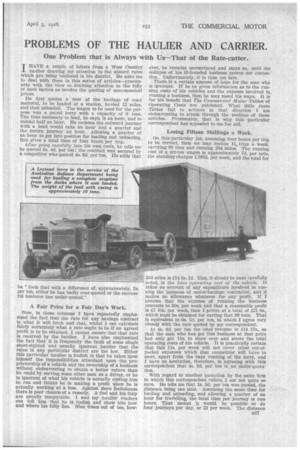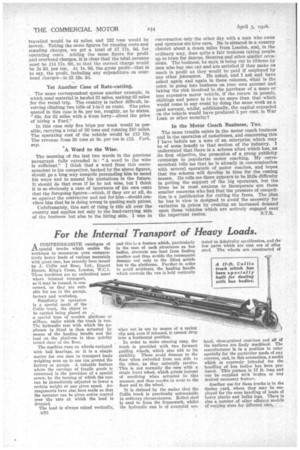PROBLEMS OF THE HAULIER AND CARRIER.
Page 71

Page 72

If you've noticed an error in this article please click here to report it so we can fix it.
One Problem that is Always with Us—That of the Rate-cutter.
T HAVE a couple of letters from a West Country 1 haulier drawing my attention to the absurd rates which are being tendered in his district. He asks me to deal with them in this series of articles—presumably with the view to drawing attention to the folly of such tactics as involve the quoting of uneconomical prices.
He first quotes a case of the haulage of road material, to be loaded at a station, hauled 12 miles, and then unloaded. The wagon to be used for the purpose was a petrol lorry with a capacity of 6 tons. The time necessary to load, he says, is an hour, and to unload half an hour. He reckons the outward journey with a load would take an hour and a quarter and the return journey an hour. Allowing a quarter of an hour to get into position for loading and unloading, this gives a total time of four hours per trip. After going carefully into his own costs, he tells me he quoted 6s. 441. per ton; the contract was secured by a competitor who quoted 4s. 64. per ton. He adds that he "feels that with a difference of, approximately, 2s. per ton, either he has badly over-quoted or the successful tenderer has under-quoted."
A Fair Price for a Fair Day's Work.
Now, in these columns I have repeatedly emphasized the fact that the rate for any haulage contract is what it will fetch and that, whilst I can calculate fairly accurately what a rate ought to be if an agreed profit is to be obtained, I cannot ensure that that rate is received by the haulier. I have also emphasized the fact that it is frequently the fault of some single short-sighted and usually ignorant haulier that the rates in any particular district are too low. Either this particular haulier is foolish in that he takes upon himself the responsibilities attendant upon the proprietorship of a vehicle and the ownership of a business without endeavouring to obtain a better return than he could by serving some other man as a driver, or he is ignorant of what his vehicle is actually costing him to run and thinks he is making a profit when he is actually working at a loss. Against Mere foolishness there is poor chance of a remedy. A fool and his folly are usually inseparable. I and my haulier readers can tell him that he is foolish and show him how and where his folly lies. Nine, times out of ten, how
ever, he remains unconvinced and stays so, until the collapse of his ill-founded business proves our contention. Unfortunately, it is then too late.
There is a certain amount of hope for the man who is ignorant. If he be given information as to the running costs of his vehicles and the expense involved in running a business, then he may mend his ways. It is for his benefit that The Commercial Motor Tables of Operating Costs are published. What little those Tables fail to achieve in that direction I am endeavouring to attain through the medium of these articles. Presumably, that is why this particular correspondent has appealed to me for aid.
Losing Fifteen Shillings a Week.
On this particular job, assuming four hours per trip to be correct, then we may reckon 1i trips a week, carrying 66 tons and running 264 miles. The running cost of a six-ton wagon is approximately 74. per mile, the standing charges 1,5854. per week, and the total for 264 miles is £14 6s. 14. This, it should be most carefully noted, is the bare operating cost of the vehicle. It takes no account of any expenditure involved in running the business of motor-haulage contractor, and it makes no allowance whatever for any profit. If I assume that the expense of running the business amounts to 30s. per week and that a reasonable profit is £5 108. per week, then I arrive at a total of 121 6s., which must be obtained for carting that 66 tons. That is equivalent to 6s. 50. per ton, in which I agree very closely with the rate quoted by my correspondent.
At 4s. 64. per ton the total revenue is £14 17s., so that the man who has got this business at that price has only got 1.1.s, to show over and above the total operating costs of his vehicle. It is practically certain that this 1.1s, per week will not cover other out-ofpocket expenses which that competitor will have to meet, apart from the bare running of the lorry, and I have no hesitation, therefore, in agreeing with this correspondent that 4s. 6d. per ton is •an under-quotation.
With regard to another quotation by the same firm to which this correspondent refers, I am not quite so sure. He tells me that is. 94. per ton was quoted, the distance being one mile. Assuming the same time for loading and unloading, and allowing a quarter of an hour for travelling, the total time per journey is two hours. That means, it would be possible to do four journeys per day, or 22 per week. The distance
travelled would be 44 miles, and 132 tons would be moved. Taking the same figures for running costsand standing charges, we get a total of £7 17s. 9d. for. operating costs. Adding the same figure for profit and overhead .charges, it is 'clear that the total.revenne must be £14 17s. 9d., so that the correct charge would be 2s 3d. per ton. At is. 9d. the. gross profit—that is to say, the profit, including any expenditure on overhead charges—is 13 13s. 3d.
Yet Another Case of Rate-cutting.
The same correspondent quotes another example, in which road material is hauled 31 miles, making 62 miles for the round trip. The country is rather difficult, involving climbing two hills of 1-in-5 en route. The price quoted in this case is Ss. per ton, roughly, as he states. "48s. for 62 miles with a 6-ton lorry—about the price of hiring a Ford."
In this case only five trips per week would be possible, carrying a total of 30 tons and running 310 miles. The operating cost of the vehicle would be 115 13s. The revenue from 30 tons at Ss. per ton is I12. Verb.
tap. •A Word to the Wise.
The meaning of the last two words in the previous paragraph fully extended is : "A word to the wise is sufficient." I think that a word from this correspondent to his competitor, backed by the above figures, should go a long way towards persuading him to mend his ways and to amend his quotations in the future. It should do that even if he be not wise, but I think It is so obviously a case of ignorance of his own costs that the foregoing figures—which, if they err at all, do so against the contractor and not for him—should convince him that he is doing wrong in quoting such prices.
Unfottunately, this sort of thing is rife all over the country and applies not only to the load-carrying side of the business but also to the hiring side. I was in conversation only the other day with a man who owns and operates sisdiire cars, He is situated in a country • district about a dozen miles from London, anti, in the ordinary way, does quite a fair business taking people up to town for dances, theatres and other _similar occasions. The business, he saYs, is being cut to ribbons by men who buy one car and are satisfied if they make as much in profit as they would be paid if employed by any other jobmaster. He asked, and I ask and have asked again and again in these columns, What is the point in going into business on your own account and taking the risk involved in the purchase of a more or less expensive motor vehicle; if the return in poundc,., shillings and pence is to be no 4:we than that which would come in any event by doing the same work as. a paid servant, whilst, additionally, the capital expended on the vehicle would have produced 5 per cent. in War Loan or other security?
In the Motor Coach Business, Ton.
The same trouble exists in the motor coach business and in the operation of motorbuses, and concerning this I have before me a note of an enterprise which may be of some benefit to that section of the industry. I understand that there is a scheme afoot which has, as its first objective, the promotion of a group publicity campaign to popularize motor coaching. My correspondent tells me that he is already in communication with several operators• of motor coaches, and hopes that the scheme will develop in time for the coming season. He tells me there appears to be little difficulty in getting the support of the big operators, but the firms he is most anxious to incorporate are those smaller concerns who feel that the pressure of competition is a justification for cutting the fares. The plan he has in view is designed to avoid the necessity for variation in prices by creating an increased demand upon those vehicles which are actively engaged over the important routes. S.T.R.




















































































































